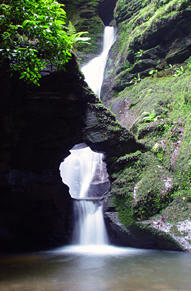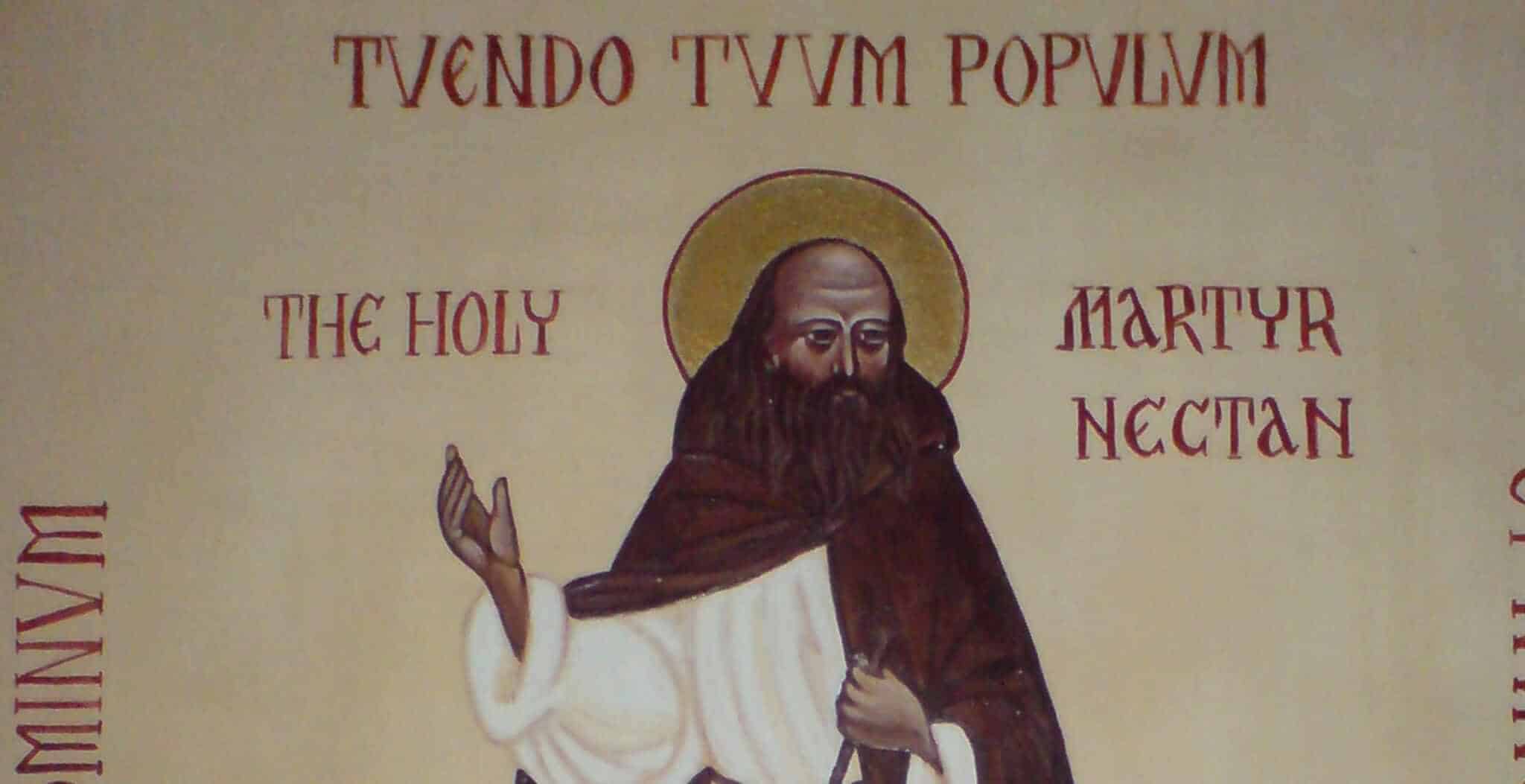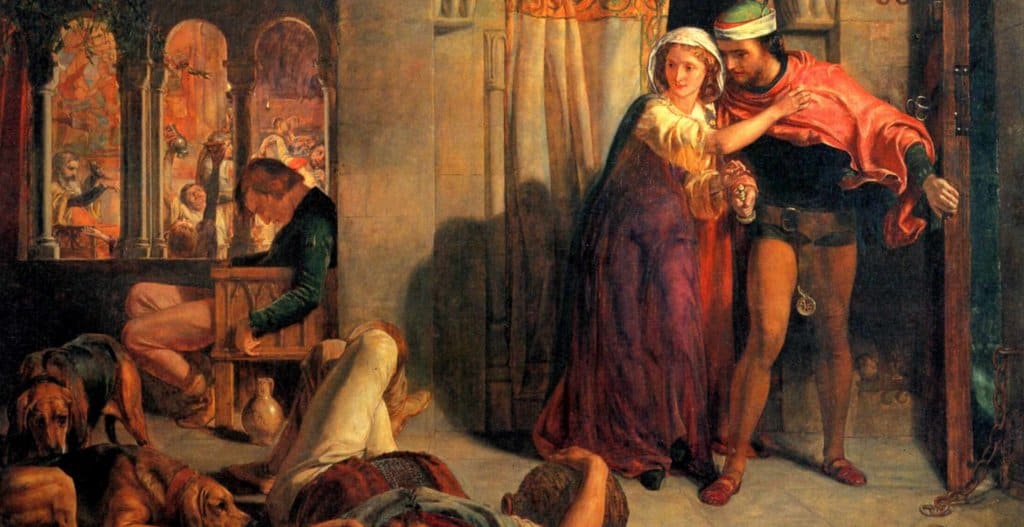St Nectan was the eldest son of King Brychan of Brycheiniog. Brychan was born in Ireland but moved to Wales when he was very young in 423 AD. St Nectan was born in 468 AD. He had 24 brothers and 24 sisters and decided to become a hermit after hearing the story of St Anthony in the Egyptian desert. He set sail from South Wales landing at Hartland Point in Devon.
Nectan lived a solitary and reclusive existence at Stoke in the Hartland Forest. The only time he wasn’t alone was when his brother and sisters came to visit each year, just after Christmas, to pray and give thanks to God.
One day in the year 510 AD when Nectan was 42, a swineherd named Huddon was wandering through the forest looking for his master’s best breeding sows. Huddon came to Nectan’s hut and asked the hermit if he’d seen the pigs. Nectan was able to show the swineherd where they were and so Huddon rewarded him with two cows.
On June 17th of that year, two passing robbers stole the cattle and headed east with them. Nectan tracked the thieves through the forest until he caught up with them. They responded by cutting off his head. Nectan picked up his head and carried it back to his home, feeling very weary (as you might without a head). He laid it on a rock by a well and collapsed. It’s said that red streaks of blood can still be seen at St Nectan’s Well in Stoke, Devon. It’s situated in a lovely location – a small wooded sanctuary down a bank from the main lane through the village. Three flagstones pave the way to the building that covers the spring. June 17th is now the feast day of St Nectan.
The tower of St Nectan’s Church, at Stoke, between Hartland Town and Hartland Point, is 144 feet high and can be seen for miles. The church dates from about 1350 AD and the tower from around 1400. There’s also a fascinating old church named after St Nectan at Welcombe, eleven miles north of Bude. Another St Nectan church lies nearby at Morenstow and behind it is a headland where locals are said to have set false beacons to lure ships in on the rocks so they could loot the wreckage.
In Irish mythology, Nectan is a wise water-god and guardian of a sacred well which was the source of all knowledge and wisdom. It was forbidden for anyone except Nectan’s up-bearers to approach the well. Anyone even looking at the water would instantly be stricken blind. A stone archway fronts the well at Stoke and there are two padlocked wooden doors to seal the waters from prying eyes.
According to the legend, a magic hazel tree grew next to the well and one day nine hazel nuts fell into the water. Fintan, a shape-changer who survived Noah’s flood by changing into a hawk to soar above the waters and then into a salmon to live in them, ate one of these nuts whilst he was a salmon. Fintan became the Salmon of Wisdom and received the knowledge of all things, but was unfortunately netted in a salmon-trap and cooked for the gods’ banquet by the Irish giant Finn MacCool. While cooking the fish, Finn accidentally touched Fintan’s flesh and absorbed the knowledge from Fintan turning Finn MacCool into a seer and healer there and then.
As with all legends there are contradicting and confusing elements. St Nectan’s legend is no exception as it’s also claimed he lived as a hermit at St Nectan’s Glen near Tintagel, which is home to St Nectan’s Waterfall and Kieve. It’s claimed that, around 500 AD, St Nectan built his sanctuary above the waterfall here. This breathtaking torrent is at the head of an idyllic hidden wooded valley, only accessible by foot. It plunges first 30 feet into a basin scoured out of the bedrock by the crashing water, flows along a narrow cleft, then plunges through a man-sized hole to fall another 10 feet into a shallow pool.

St. Nectan’s waterfall near Tintagel, Cornwall.
About a mile further down St Nectan’s Glen is a pair of remarkable rock carvings set into the valley’s crags. These carvings are small mazes known as finger labyrinths just over an inch in diameter. If you follow the maze with your finger you’re drawn to the labyrinth’s core. Some claim that these carvings are maps of the maze that lead to the top of Glastonbury Tor. They’re believed to be 4000 years old.
Several public footpaths approach St.Nectan’s Glen. The main one is behind the Rocky Valley Centre at Trethevy on the Boscastle to Tintagel road. Sensible footwear is a necessity as it’s extremely rocky and slippery when wet on the route to the spot where St Nectan is reputed to have lived in a cell. The remains of the chapel is now the owners living accommodation and it’s beneath this that the room reputed to be the site of St Nectan’s cell can be found. Slate steps lead up to the chapel and the rear bedrock wall forms a natural altar.
Legend states that Nectan owned a small silver bell, which he kept in a tall tower high above the waterfall. During the violent storms that sometimes ravaged this isolated spot, St Nectan would ring the bell and save ships that would otherwise have been smashed on the rocks. He believed that the marauding Romans were ravaging his faith, so before he died he vowed that unbelievers would never hear the bell and he threw it into the basin of the waterfall. If the bell is heard today, bad luck will follow. Parallels can be made with events that occurred at Morwenstow and indeed it was Parson Hawker (reverend of both the St Nectan churches at Welcombe and Morwenstow at different times) who claimed this site was known as St Nectan’s Kieve.
Ghostly monks have been witnessed chanting along the pilgrim path as well as two spectral grey women, said to be St Nectan’s sisters who are buried beneath a large flat slab in the river, near the bottom of the waterfall. St Nectan himself is said to be buried in an oak chest somewhere below the river.



